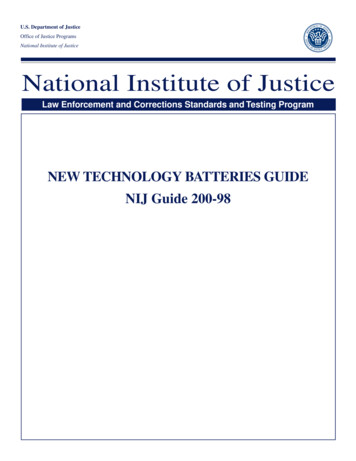
Transcription
NT OF JUSSG OVCRAMSDEPANBJ A C EIOF FOffice of Justice ProgramsMERTCETIU.S. Department of JusticeIJJO F OJJ D P B ROJ US T I C E PNational Institute of JusticeNational Institute of JusticeLaw Enforcement and Corrections Standards and Testing ProgramNEW TECHNOLOGY BATTERIES GUIDENIJ Guide 200-98
ABOUT THE LAW ENFORCEMENT AND CORRECTIONSSTANDARDS AND TESTING PROGRAMThe Law Enforcement and Corrections Standards and Testing Program is sponsored by the Office of Science andTechnology of the National Institute of Justice (NIJ), U.S. Department of Justice. The program responds to the mandateof the Justice System Improvement Act of 1979, which created NIJ and directed it to encourage research anddevelopment to improve the criminal justice system and to disseminate the results to Federal, State, and local agencies.The Law Enforcement and Corrections Standards and Testing Program is an applied research effort thatdetermines the technological needs of justice system agencies, sets minimum performance standards for specific devices,tests commercially available equipment against those standards, and disseminates the standards and the test results tocriminal justice agencies nationally and internationally.The program operates through:The Law Enforcement and Corrections Technology Advisory Council (LECTAC) consisting of nationallyrecognized criminal justice practitioners from Federal, State, and local agencies, which assesses technological needsand sets priorities for research programs and items to be evaluated and tested.The Office of Law Enforcement Standards (OLES) at the National Institute of Standards and Technology, whichdevelops voluntary national performance standards for compliance testing to ensure that individual items of equipmentare suitable for use by criminal justice agencies. The standards are based upon laboratory testing and evaluation ofrepresentative samples of each item of equipment to determine the key attributes, develop test methods, and establishminimum performance requirements for each essential attribute. In addition to the highly technical standards, OLESalso produces technical reports and user guidelines that explain in nontechnical terms the capabilities of availableequipment.The National Law Enforcement and Corrections Technology Center (NLECTC), operated by a grantee, whichsupervises a national compliance testing program conducted by independent laboratories. The standards developed byOLES serve as performance benchmarks against which commercial equipment is measured. The facilities, personnel,and testing capabilities of the independent laboratories are evaluated by OLES prior to testing each item of equipment,and OLES helps the NLECTC staff review and analyze data. Test results are published in Equipment PerformanceReports designed to help justice system procurement officials make informed purchasing decisions.Publications are available at no charge from the National Law Enforcement and Corrections Technology Center.Some documents are also available online through the Internet/World Wide Web. To request a document or additionalinformation, call 800-248-2742 or 301-519-5060, or write:National Law Enforcement and Corrections Technology CenterP.O. Box 1160Rockville, MD 20849-1160E-mail: asknlectc@nlectc.orgWorld Wide Web address: http://www.nlectc.orgThe National Institute of Justice is a component of the Office of JusticePrograms, which also includes the Bureau of Justice Assistance, Bureau ofJustice Statistics, Office of Juvenile Justice and Delinquency Prevention, andthe Office for Victims of Crime.
National Institute of JusticeJeremy TravisDirectorThe Technical effort to develop this Guide was conductedunder Interagency Agreement 94-IJ-R-004Project No. 97-027-CTT.This Guide was prepared by the Office of LawEnforcement Standards (OLES) of theNational Institute of Standards and Technology (NIST)under the direction of A. George Lieberman,Program Manager for Communications Systems,and Kathleen M. Higgins, Director of OLES.The work resulting in this guide was sponsored bythe National Institute of Justice, David G. Boyd,Director, Office of Science and Technology.
New Technology Batteries GuideFOREWORDThe Office of Law Enforcement Standards (OLES) of the National Institute of Standardsand Technology furnishes technical support to the National Institute of Justice program tostrengthen law enforcement and criminal justice in the United States. OLES’s function is toconduct research that will assist law enforcement and criminal justice agencies in the selectionand procurement of quality equipment.OLES is: (1) subjecting existing equipment to laboratory testing and evaluation, and (2)conducting research leading to the development of several series of documents, includingnational standards, user guides, and technical reports.This document covers research conducted by OLES under the sponsorship of the NationalInstitute of Justice. Additional reports as well as other documents are being issued under theOLES program in the areas of protective clothing and equipment, communications systems,emergency equipment, investigative aids, security systems, vehicles, weapons, and analyticaltechniques and standard reference materials used by the forensic community.Technical comments and suggestions concerning this report are invited from all interestedparties. They may be addressed to the Director, Office of Law Enforcement Standards, NationalInstitute of Standards and Technology, Gaithersburg, MD 20899.David G. Boyd, DirectorOffice of Science and TechnologyNational Institute of Justiceiii
New Technology Batteries Guideiv
New Technology Batteries GuideBACKGROUNDThe Office of Law Enforcement Standardsconventional format, that details the(OLES) was established by the Nationalperformance that the equipment is required toInstitute of Justice (NIJ) to provide focus on twogive, and describes test methods by which itsmajor objectives: (1) to find existing equipmentactual performance can be measured. Thesewhich can be purchased today, and (2) torequirements are technical, and are stated indevelop new law-enforcement equipment whichterms directly related to the equipment’s use.can be made available as soon as possible. AThe basic purposes of a standard are (1) to be apart of OLES’s mission is to become thoroughlyreference in procurement documents created byfamiliar with existing equipment, to evaluate itspurchasing officers who wish to specifyperformance by means of objective laboratoryequipment of the “standard” quality, and (2) totests, to develop andidentify objectivelyimprove theseequipment ofmethods of test, toacceptabledevelop performanceA standard is not intended to inform performance.standards forand guide the reader; that is theselected equipmentNote that a standardfunction of a guidelineitems, and to prepareis not intended toguidelines for theinform and guide theselection and use ofreader; that is thethis equipment. All of these activities arefunction of a “guideline.” Guidelines are writtendirected toward providing law enforcementin non-technical language and are addressed toagencies with assistance in making goodthe potential user of the equipment. Theyequipment selections and acquisitions ininclude a general discussion of the equipment,accordance with their own requirements.its important performance attributes, the variousmodels currently on the market, objective testAs the OLES program has matured, there hasdata where available, and any other informationbeen a gradual shift in the objectives of thethat might help the reader make a rationalOLES projects. The initial emphasis on theselection among the various options ordevelopment of standards has decreased, and thealternatives available to him or her.emphasis on the development of guidelines hasincreased. For the significance of this shift inThis battery guide is provided to inform theemphasis to be appreciated, the precisereader of the latest technology related to batterydefinitions of the words “standard” andcomposition, battery usage, and battery charging“guideline” as used in this context must betechniques.clearly understood.Kathleen HigginsA “standard” for a particular item of equipmentNational Institute of Standards and Technologyis understood to be a formal document, in aMarch 27, 1997v
New Technology Batteries Guidevi
New Technology Batteries GuideCONTENTSpageFOREWORD . . . . . . . . . . . . . . . . . . . . . . . . . . . . . . . iiiBACKGROUND . . . . . . . . . . . . . . . . . . . . . . . . . . . . vCONTENTS . . . . . . . . . . . . . . . . . . . . . . . . . . . . . . . viiList of Figures . . . . . . . . . . . . . . . . . . . . . . . . . . . . . viiiList of Tables . . . . . . . . . . . . . . . . . . . . . . . . . . . . . . viiiList of Equations . . . . . . . . . . . . . . . . . . . . . . . . . . . viii1. Fundamentals of Battery Technology . . . . . . . . . .1.1 What is a Battery? . . . . . . . . . . . . . . . . . . . . .1.2 How Does a Battery Work? . . . . . . . . . . . . . .1.3 Galvanic Cells vs. Batteries . . . . . . . . . . . . . .1.4 Primary Battery . . . . . . . . . . . . . . . . . . . . . . .1.5 Secondary Battery . . . . . . . . . . . . . . . . . . . . .1.6 Battery Labels . . . . . . . . . . . . . . . . . . . . . . . .11133332. Available Battery Types . . . . . . . . . . . . . . . . . . . . 52.1 General . . . . . . . . . . . . . . . . . . . . . . . . . . . . . 52.1.1 Acid vs. Alkaline . . . . . . . . . . . . . . . . . 52.1.2 Wet vs. Dry . . . . . . . . . . . . . . . . . . . . . 52.1.3 Categories . . . . . . . . . . . . . . . . . . . . . . 52.2 Vehicular Batteries . . . . . . . . . . . . . . . . . . . . 62.2.1 Lead-Acid. 62.2.2 Sealed vs. Flooded . . . . . . . . . . . . . . . 62.2.3 Deep-Cycle Batteries . . . . . . . . . . . . . . 72.2.4 Battery Categories for VehicularBatteries . . . . . . . . . . . . . . . . . . . . . . . . 72.3 “Household” Batteries . . . . . . . . . . . . . . . . . . 72.3.1 Zinc-carbon (Z-C) . . . . . . . . . . . . . . . . 82.3.2 Zinc-Manganese Dioxide Alkaline Cells(“Alkaline Batteries”) . . . . . . . . . . . . . 82.3.3 Rechargeable Alkaline Batteries . . . . . 92.3.4 Nickel-Cadmium (Ni-Cd) . . . . . . . . . . 92.3.5 Nickel-Metal Hydride (Ni-MH) . . . . 102.3.6 Nickel-Iron (Ni-I) . . . . . . . . . . . . . . . 102.3.7 Nickel-Zinc (Ni-Z) . . . . . . . . . . . . . .2.3.8 Lithium and Lithium Ion . . . . . . . . . .2.4 Specialty Batteries (“Button” and MiniatureBatteries) . . . . . . . . . . . . . . . . . . . . . . . . . . . .2.4.1 Metal-Air Cells . . . . . . . . . . . . . . . . .2.4.2 Silver Oxide . . . . . . . . . . . . . . . . . . .2.4.3 Mercury Oxide . . . . . . . . . . . . . . . . .2.5 Other Batteries . . . . . . . . . . . . . . . . . . . . . . .2.5.1 Nickel-Hydrogen (Ni-H) . . . . . . . . . .2.5.2 Thermal Batteries . . . . . . . . . . . . . . .2.5.3 Super Capacitor . . . . . . . . . . . . . . . . .2.5.4 The Potato Battery . . . . . . . . . . . . . . .2.5.5 The Sea Battery . . . . . . . . . . . . . . . . .2.5.6 Other Developments . . . . . . . . . . . . .10103. Performance, Economics and Tradeoffs . . . . . . .3.1 Energy Densities . . . . . . . . . . . . . . . . . . . . .3.2 Energy per Mass . . . . . . . . . . . . . . . . . . . . .3.3 Energy Per Volume . . . . . . . . . . . . . . . . . . .3.4 Memory Effects . . . . . . . . . . . . . . . . . . . . . .3.5 Voltage Profiles . . . . . . . . . . . . . . . . . . . . . .3.6 Self-Discharge Rates . . . . . . . . . . . . . . . . . .3.7 Operating Temperatures . . . . . . . . . . . . . . .3.8 Cycle Life . . . . . . . . . . . . . . . . . . . . . . . . . .3.9 Capacity Testing . . . . . . . . . . . . . . . . . . . . .3.10 Battery Technology Comparison . . . . . . . .15151515161617171818184. Selecting the Right Battery for the Application .4.1 Battery Properties . . . . . . . . . . . . . . . . . . . .4.2 Environmental Concerns . . . . . . . . . . . . . . .4.3 Standardization . . . . . . . . . . . . . . . . . . . . . .4.4 Testing Capacities . . . . . . . . . . . . . . . . . . . .4.5 Mobile Radios . . . . . . . . . . . . . . . . . . . . . . .4.6 Cellular Phones and PCS Phones . . . . . . . .4.7 Laptop Computers . . . . . . . . . . . . . . . . . . . .4.8 Camcorders . . . . . . . . . . . . . . . . . . . . . . . . .4.9 Summary . . . . . . . . . . . . . . . . . . . . . . . . . . .2324242626272728282912121213131313131414145. Battery Handling and Maintenance . . . . . . . . . . . 315.1 Battery Dangers . . . . . . . . . . . . . . . . . . . . . . 315.2 Extending Battery Life . . . . . . . . . . . . . . . . 33vii
New Technology Batteries GuideList of Figures6. Battery Chargers and Adapters . . . . . . . . . . . . . .6.1 Battery Chargers . . . . . . . . . . . . . . . . . . . . .6.2 Charge Rates . . . . . . . . . . . . . . . . . . . . . . . .6.3 Charging Techniques . . . . . . . . . . . . . . . . . .6.4 Charging Lead-Acid Batteries . . . . . . . . . . .6.5 Charging Ni-Cd Batteries . . . . . . . . . . . . . .6.6 Timed-Charge Charging . . . . . . . . . . . . . . .6.7 Pulsed Charge-Discharge Chargers . . . . . . .6.8 Charging Button Batteries . . . . . . . . . . . . . .6.9 Internal Chargers . . . . . . . . . . . . . . . . . . . . .6.10 Battery Testers . . . . . . . . . . . . . . . . . . . . . .6.11 “Smart” Batteries . . . . . . . . . . . . . . . . . . . .6.12 End of Life . . . . . . . . . . . . . . . . . . . . . . . .6.13 Battery Adapters . . . . . . . . . . . . . . . . . . . .35353636363737383838383939407. Products and Suppliers . . . . . . . . . . . . . . . . . . . .7.1 Battery Manufacturers . . . . . . . . . . . . . . . . .7.1.1 Battery Engineering . . . . . . . . . . . . . .7.1.2 Duracell . . . . . . . . . . . . . . . . . . . . . . .7.1.3 Eveready . . . . . . . . . . . . . . . . . . . . . .7.1.4 Rayovac . . . . . . . . . . . . . . . . . . . . . . .4141424242428. A Glossary of Battery Terms . . . . . . . . . . . . . . . 439. Bibliography . . . . . . . . . . . . . . . . . . . . . . . . . . . . 51pageFigure 1. Conceptual diagram of a galvanic cell. . . . 1Figure 2. Energy densities, W#h/kg, of various batterytypes (adapted from NAVSO P-3676). . . . . . . . 15Figure 3. Energy densities, W#h/L, of various batterytypes (adapted from NAVSO P-3676). . . . . . . . 16Figure 4. Flat discharge curve vs. sloping dischargecurve. . . . . . . . . . . . . . . . . . . . . . . . . . . . . . . . . . 17Figure 5. Performance comparison of primary andsecondary alkaline and Ni-Cd batteries (adaptedfrom Design Note: Renewable Reusable AlkalineBatteries). . . . . . . . . . . . . . . . . . . . . . . . . . . . . . . 23List of TablespageTable 1. The Electromotive Series for Some BatteryComponents . . . . . . . . . . . . . . . . . . . . . . . . . . . . . 2Table 2. Various Popular Household-Battery Sizes . 8Table 3. Battery Technology Comparison (adapted fromDesign Note: Renewable Reusable AlkalineBatteries) . . . . . . . . . . . . . . . . . . . . . . . . . . . . . . 19Table 4. A Comparison of Several Popular BatteryTypes . . . . . . . . . . . . . . . . . . . . . . . . . . . . . . . . . 20Table 5. Recommended Battery Types for VariousUsage Conditions . . . . . . . . . . . . . . . . . . . . . . . . 25Table 6. Typical Usage of PortableTelecommunications Equipment. . . . . . . . . . . . . 27Table 7. Charge Rate Descriptions . . . . . . . . . . . . . 35Table 8. Some On-Line Information Available via theWorld Wide Web . . . . . . . . . . . . . . . . . . . . . . . . 41List of EquationspageEquation 1. The chemical reaction in a lead-acidbattery. . . . . . . . . . . . . . . . . . . . . . . . . . . . . . . . . . 6Equation 2. The chemical reaction in a Leclanché cell. 8Equation 3. The chemical reaction in a nickelcadmium battery. . . . . . . . . . . . . . . . . . . . . . . . . . 9Equation 4. The chemical reaction in a lithiummanganese dioxide cell. . . . . . . . . . . . . . . . . . . . 11viii
New Technology Batteries GuideCOMMONLY USED SYMBOLS AND .FMftft/sgggramperealternating currentamplitude modulationcandelacentimeterchemically purecycle per seconddaydecibeldirect currentdegree Celsiusdegree Fahrenheitdiameterelectromotive forceequationfaradfootcandlefigurefrequency modulationfootfoot per LLlblbflbf#inlmlnlogMmminmmmphm/sNN #mhenryhourhigh frequencyhertz (c/s)inside rcepound-force inchlumenlogarithm (natural)logarithm (common)molarmeterminutemillimetermile per hourmeter per secondnewtonnewton vVvhfW wtnanometernumberoutside diameterohmpagepascalprobable errorpagespart per millionquartradianradio frequencyrelative humiditysecondstandard deviationsectionstanding wave ratioultrahigh frequencyultravioletvoltvery high frequencywattwavelengthweightarea unit2 (e.g., ft2, in2, etc.); volume unit3 (e.g., ft2, m3, etc.)PREFIXESdcmµnpdeci (10-1)centi (10-2)milli (10-3)micro (10-6)nano (10-9)pico (10-12)dahkMGTdeka (10)hecto (102)kilo (103)mega (106)giga (109)tera (1012)COMMON CONVERSIONS (See ASTM E380)ft/s 0.3048000 m/sft 0.3048 mft#lbf 1.355818 Jgr 0.06479891 gin 2.54 cmkWh 3600000 Jlb 0.4535924 kglbf 4.448222 Nlbf/ft 14.59390 N/mlbf#in 0.1129848 N #mlbf/in2 6894.757 Pamph1.609344 km/hqt 0.9463529 L#Temperature: (T F 32) 5/9 T CTemperature: (T C C9/5) 32 T F((((ix
New Technology Batteries Guidex
1. Fundamentals of Battery Technologywires connect the electrodes to an electricalload (a light bulb in this case). The metal inA battery, in concept, can be any device thatthe anode (the negative terminal) oxidizesstores energy for later use. A rock, pushed to(i.e., it “rusts”), releasing negatively chargedthe top of a hill, can be considered a kind ofelectrons and positively charged metal ions.battery, since the energy used to push it up theThe electrons travel through the wire (and thehill (chemical energy, from muscles orelectrical load) to the cathode (the positivecombustion engines) is converted and storedterminal). The electrons combine with theas potential kinetic energy at the top of thematerial in the cathode. This combinationhill. Later, that energy is released as kineticprocess is called reduction, and it releases aand thermal energy when the rock rolls downnegatively charged metal-oxide ion. At thethe hill.interface with theelectrolyte, this ionCommon use of thecauses a waterword, “battery,”molecule to splithowever, is limitedinto a hydrogen ionto an electroand a hydroxidechemical deviceion. The positivelythat convertscharged hydrogenchemical energyion combines withinto electricity, bythe negativelyuse of a galvaniccharged metalcell. A galvanic celloxide ion andis a fairly simplebecomes inert. Thedevice consisting ofnegatively chargedtwo electrodes (anhydroxide ionanode and aFigure 1. Conceptual diagram of a galvanic cell.flows through thecathode) and anelectrolyte to theelectrolyte solution. Batteries consist of one oranode where it combines with the positivelymore galvanic cells.charged metal ion, forming a water moleculeand a metal-oxide molecule.1.2 HOW DOES A BATTERY WORK?1.1 WHAT IS A BATTERY?Figure 1 shows a simple galvanic cell.Electrodes (two plates, each made from adifferent kind of metal or metallic compound)are placed in an electrolyte solution. ExternalIn effect, metal ions from the anode will“dissolve” into the electrolyte solution whilehydrogen molecules from the electrolyte aredeposited onto the cathode.1
New Technology Batteries GuideWhen the anode is fully oxidized or thecathode is fully reduced, the chemical reactionwill stop and the battery is considered to bedischarged.Recharging a battery is usually a matter ofexternally applying a voltage across the platesto reverse the chemical process. Somechemical reactions, however, are difficult orimpossible to reverse. Cells with irreversiblereactions are commonly known as primarycells, while cells with reversible reactions areknown as secondary cells. It is dangerous toattempt to recharge primary cells.The amount of voltage and current that agalvanic cell produces is directly related to thetypes of materials used in the electrodes andelectrolyte. The length of time the cell canproduce that voltage and current is related tothe amount of active material in the cell andthe cell’s design.Every metal or metal compound has anelectromotive force, which is the propensity ofthe metal to gain or lose electrons in relationto another material. Compounds with apositive electromotive force will make goodanodes and those with a negative force willmake good cathodes. The larger the differencebetween the electromotive forces of the anodeand cathode, the greater the amount of energythat can be produced by the cell. Table 1shows the electromotive force of somecommon battery components.2Table 1. The Electromotive Series for SomeBattery ComponentsAnode Materials(Listed from worst[most positive] to best[most negative])Cathode Materials(Listed from best[most positive] toworst [most negative])GoldFerratePlatinumIron OxideMercuryCuprous OxidePalladiumIodateSilverCupric OxideCopperMercuric OxideHydrogenCobaltic OxideLeadManganese DioxideTinLead DioxideNickelSilver OxideIronOxygenChromiumNickel OxyhydroxideZincNickel DioxideAluminumSilver PeroxideMagnesiumPermanganateLithiumBromateOver the years, battery specialists haveexperimented with many differentcombinations of material and have generallytried to balance the potential energy output ofa battery with the costs of manufacturing thebattery. Other factors, such as battery weight,shelf life, and environmental impact, alsoenter into a battery’s design.
New Technology Batteries Guide1.3 GALVANIC CELLS VS. BATTERIESFrom earlier discussion, we know that abattery is one or more galvanic cells connectedin series or in parallel.A battery composed of two 1.5 V galvaniccells connected in series, for example, willproduce 3 V. A typical 9 V battery is simplysix 1.5 V cells connected in series. Such aseries battery, however, will produce a currentthat is the equivalent to just one of thegalvanic cells.diminished capacity), it is more likely that thebattery will simply fail to hold any charge, willleak electrolyte onto the battery charger, orwill overheat and cause a fire. It is unwise anddangerous to recharge a primary battery.1.5 SECONDARY BATTERYA secondary battery is commonly known as arechargeable battery. It is usually designed tohave a lifetime of between 100 and 1000recharge cycles, depending on the compositematerials.A battery composed of two 1.5 V galvanicSecondary batteries are, generally, more costcells connected in parallel, on the other hand,effective over time than primary batteries,will still produce asince the batteryvoltage of 1.5 V,can be rechargedbut the currentand reused. AA battery is one or more galvanicprovided can besingle dischargecells connected in series or indouble the currentcycle of a primaryparallelthat just one cellbattery, however,would create. Suchwill provide morea battery cancurrent for a longerprovide current twice as long as a single cell.period of time than a single discharge cycle ofan equivalent secondary battery.Many galvanic cells can be thus connected tocreate a battery with almost any current at any1.6 BATTERY LABELSvoltage level.The American National Standards Institute(ANSI) Standard, ANSI C18.1M-1992, lists1.4 PRIMARY BATTERYseveral battery features that must be listed on aA primary battery is a battery that is designedbattery’s label. They are:to be cycled (fully discharged) only once andthen discarded. Although primary batteries areManufacturer -- The name of the batteryoften made from the same base materials asmanufacturer.secondary (rechargeable) batteries, the designANSI Number -- The ANSI/NEDAand manufacturing processes are not the same.number of the battery.Date -- The month and year that the batteryBattery manufacturers recommend thatwas manufactured or the month and year thatprimary batteries not be recharged. Althoughthe battery “expires” (i.e., is no longerattempts at recharging a primary battery willguaranteed by the manufacturer).occasionally succeed (usually with aVoltage -- The nominal battery voltage.3
New Technology Batteries GuidePolarity -- The positive and negativeterminals. The terminals must be clearlymarked.Warnings -- Other warnings and cautionsrelated to battery usage and disposal.4
2. Available Battery Types2.1 GENERAL2.1.1 Acid vs. AlkalineBatteries are often classified by the type ofelectrolyte used in their construction. Thereare three common classifications: acid, mildlyacid, and alkaline.Acid-based batteries often use sulphuric acidas the major component of the electrolyte.Automobile batteries are acid-based. Theelectrolyte used in mildly acidic batteries is farless corrosive than typical acid-based batteriesand usually includes a variety of salts thatproduce the desired acidity level. Inexpensivehousehold batteries are mildly acidic batteries.Alkaline batteries typically use sodiumhydroxide or potassium hydroxide as the maincomponent of the electrolyte. Alkalinebatteries are often used in applications wherelong-lasting, high-energy output is needed,such as cellular phones, portable CD players,radios, pagers, and flash cameras.2.1.2 Wet vs. Dry“Wet” cells refer to galvanic cells where theelectrolyte is liquid in form and is allowed toflow freely within the cell casing. Wetbatteries are often sensitive to the orientationof the battery. For example, if a wet cell isoriented such that a gas pocket accumulatesaround one of the electrodes, the cell will notproduce current. Most automobile batteries arewet cells.“Dry” cells are cells that use a solid orpowdery electrolyte. These kind of electrolytesuse the ambient moisture in the air tocomplete the chemical process. Cells withliquid electrolyte can be classified as “dry” ifthe electrolyte is immobilized by somemechanism, such as by gelling it or by holdingit in place with an absorbent substance such aspaper.In common usage, “dry cell” batteries willusually refer to zinc-carbon cells (Sec. 2.3.1)or zinc-alkaline-manganese dioxide cells(Sec. 2.3.2), where the electrolyte is oftengelled or held in place by absorbent paper.Some cells are difficult to categorize. Forexample, one type of cell is designed to bestored for long periods without its electrolytepresent. Just before power is needed from thecell, liquid electrolyte is added.2.1.3 CategoriesBatteries can further be classified by theirintended use. The following sections discussfour generic categories of batteries;“vehicular” batteries (Sec. 2.2), “household”batteries (Sec. 2.3), “specialty” batteries (Sec.2.4), and “other” batteries (Sec. 2.5). Eachsection will focus on the general properties ofthat category of battery.Note that some battery types (acidic oralkaline, wet or dry) can fall into severaldifferent categories. For this guideline, batterytypes are placed into the category in which5
New Technology Batteries Guidethey are most likely to be found in commercialusage.Equation 1 shows the chemical reaction in alead-acid cell.2.2 VEHICULAR BATTERIESThis section discusses battery types andconfigurations that are typically used in motorvehicles. This category can include batteriesthat drive electric motors directly or those thatprovide starting energy for combustionengines. This category will also include large,stationary batteries used as power sources foremergency building lighting, remote-sitepower, and computer back up.Vehicular batteriesare usuallyavailable off-theshelf in standarddesigns or can becustom built forspecificapplications.Batterylargest use for lead in the world.Encyclopedia of Physical Science andTechnology, Brooke Schumm, Jr., 1992.6Equation 1. The chemical reaction in a leadacid battery.Lead-acid batteries remain popular becausethey can produce high or low currents over awide range of temperatures, they have goodshelf life and life cycles, and they arerelatively inexpensive to manufacture. Leadacid batteries areusuallyrechargeable.manufacturing is the single2.2.1 Lead-AcidLead-acid batteries,developed in the late 1800s, were the firstcommercially practical batteries. Batteries ofthis type remain popular because they arerelatively inexpensive to produce and sell. Themost widely known uses of lead-acid batteriesare as automobile batteries. Rechargeablelead-acid batteries have become the mostwidely used type of battery in theworld—more than 20 times the use rate of itsnearest rivals. In fact, battery manufacturing isthe single largest use for lead in the world.11PbO2 Pb 2H2SO4 2PbSO4 2H2OLead-acid batteriescome in all mannerof shapes and sizes,from household batteries to large batteries foruse in submarines. The most noticeableshortcomings of lead-acid batteries are theirrelatively heavy weight and their fallingvoltage profile during discharge (Sec. 3.5).2.2.2 Sealed vs. FloodedIn “flooded” batteries, the oxygen created atthe positive electrode is released from the celland vented into the atmosphere. Similarly, thehydrogen created at the negative electrode isalso vented into the atmosphere. The overallresult is a net loss of water (H2O) from thecell. This lost water needs to be periodicallyreplaced. Flooded batteries must be vented toprevent excess pressure from the build up ofthese gases. Also, the room or enclosurehousing the battery must be vented, since aconcentrated hydrogen and oxygenatmosphere is explosive.
New Technology Batteries GuideIn sealed batteries, however, the generatedoxygen combines chemically with the lead andthen the hydrogen at the negative electrode,and then again with reactive agents in theelectrolyte, to recreate water. The net result isno significant loss of water from the cell.2.2.3 Deep-Cycle BatteriesDeep-cycle batteries are built in configurationssimilar to those of regular batteries, exceptthat they are specifically designe
Director The Technical effort to develop this Guide was conducted under Interagency Agreement 94-IJ-R-004 Project No. 97-027-CTT. This Guide was prepared by the Office of Law Enforcement Standards (OLES) of the National Institute of Standards and Technology (NIST) under the direction of A. George Lieberman, Program Manager for Communications .











